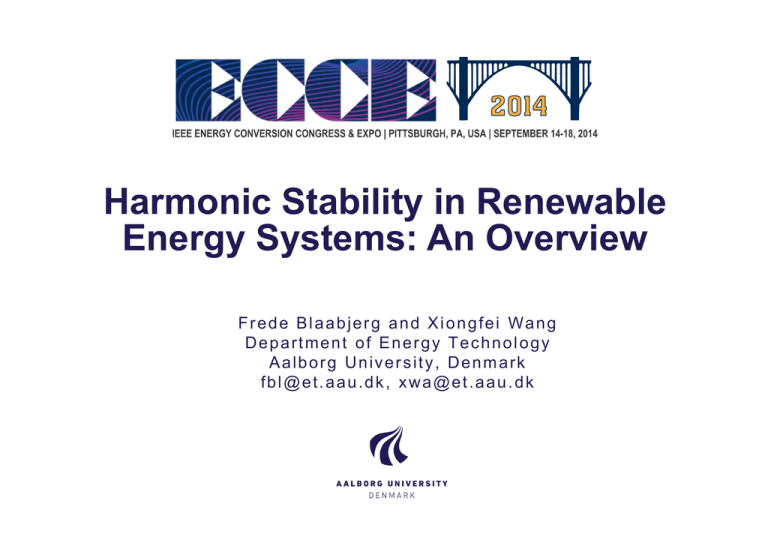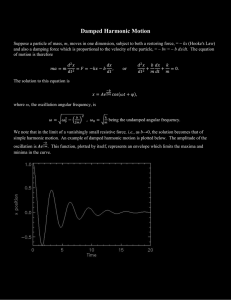Harmonic Stability in Renewable Energy Systems: An Overview
advertisement

Harmonic Stability in Renewable
Energy Systems: An Overview
Frede Blaabjerg and Xiongfei Wang
Department of Energy Technology
Aalborg University, Denmark
fbl@et.aau.dk, xwa@et.aau.dk
Outline
Introduction
•
State-of-the-art
•
Harmonic stability concept
Modeling and Analysis of Harmonic Stability
•
Modeling of power system components
•
Harmonic stability analysis
Mitigation of Harmonic Instability
•
Passive damping of filters
•
Active damper
Conclusions
HARMONIC STABILITY IN RENEWABLE ENERGY SYSTEM–FREDE BLAABJERG 2 | 17.09.2014
State-of-the-Art
Power Electronics Enabling Sustainable and Flexible Power Grids
HARMONIC STABILITY IN RENEWABLE ENERGY SYSTEM–FREDE BLAABJERG 3 | 17.09.2014
State-of-the-Art
Large Wind Generator
Traditional Generator
Wideband harmonics will be aggravated
Prime Mover
Excitation Control
0.1Hz
1Hz
Traditional Generator Output Voltage
Turbine P & ω Control
0.1Hz
Grid Q &V Control
DC-Link Control
10Hz
Grid Synchronization
100Hz
Current Control
500Hz
Semiconductor Switching
2500Hz
Wind Generator Output Voltage
Harmonic Spectrum
HARMONIC STABILITY IN RENEWABLE ENERGY SYSTEM–FREDE BLAABJERG 4 | 17.09.2014
State-of-the-Art
Wideband controller interactions of converters – harmonic stability
Power Converter
GRID
LCL Filter
Power Cable
Power Transformer
Wind Power Plant
HARMONIC STABILITY IN RENEWABLE ENERGY SYSTEM–FREDE BLAABJERG 5 | 17.09.2014
Harmonic Stability Concept
Harmonic Instability v.s. Harmonic Resonance
Ideal
Real
General
Re{Yo}>0, stable but may be still resonate
Re{Yo}=0, critically stable (resonance)
Re{Yo}<0, unstable with amplified resonance
Re{Zg} + Re{Yo} ?
HARMONIC STABILITY IN RENEWABLE ENERGY SYSTEM–FREDE BLAABJERG 6 | 17.09.2014
Modeling and Analysis of Harmonic Stability
•
Modeling of power system components
•
Harmonic stability analysis
HARMONIC STABILITY IN RENEWABLE ENERGY SYSTEM–FREDE BLAABJERG 7 | 17.09.2014
Modeling of Power System Components
Traditionally Sine Wave → Currently Square Wave
Power Electronics
Passive Filters
Sinusoidal
Power Lines & Cables
Square
Transformers
HARMONIC STABILITY IN RENEWABLE ENERGY SYSTEM–FREDE BLAABJERG 8 | 17.09.2014
Modeling of Power System Components
Power Electronics Based Sources and Loads
State-space averaging
(High pulse ratio, LTI)
Small-signal
modeling
Modeling
methods
Power Electronics
Switch-Mode
Converters
Control
Bandwidth
Harmonic state-space
(Low pulse ratio, LTP)
Harmonic linearization
Large-signal
modeling
Feedback linearization
Current &
voltage control
Harmonic instability
Power control
& PLL
Sub-harmonic instability
Low-order harmonics
Dead-time
Damping of resonance
Nonlinear
phenomena
Impedance of
power switch
Parasitic capacitors
HARMONIC STABILITY IN RENEWABLE ENERGY SYSTEM–FREDE BLAABJERG 9 | 17.09.2014
Modeling of Power System Components
Small-Signal Modeling of Power Electronics Converters
HARMONIC STABILITY IN RENEWABLE ENERGY SYSTEM–FREDE BLAABJERG 10 | 17.09.2014
Modeling of Power System Components
Harmonic State Space Modeling of Converters
HARMONIC STABILITY IN RENEWABLE ENERGY SYSTEM–FREDE BLAABJERG 11 | 17.09.2014
Modeling of Power System Components
Harmonic State-Space
Harmonic Domain
,
,
0, dynamically time
varying signals
0, fixed periodic signal
∈
∈
Time domain signal with transient
Mag(volt)
200
100
0
-100
0
0.02
0.04
0.06
0.08
0.1
0.12
time(sec)
1st order signal
0.14
0.16
0.18
0.2
0.02
0.04
0.06
0.08
0.14
0.16
0.18
0.2
0.14
0.16
0.18
0.2
0.14
0.16
0.18
0.2
Mag(volt)
50
0
-50
Mag(volt)
2
⋮
0
x 10
-15
0.1
0.12
time(sec)
3rd order signal
0
-2
0
0.02
0.04
0.06
0.08
0.1
0.12
time(sec)
5th order signal
0
0.02
0.04
0.06
0.08
Mag(volt)
5
0
-5
0.1
0.12
time(sec)
HARMONIC STABILITY IN RENEWABLE ENERGY SYSTEM–FREDE BLAABJERG 12 | 17.09.2014
Modeling of Power System Components
Power Lines and Cables
Lumped parameter – Π model (Γ model, T model)
Long line correction
sinh( )
tanh( 2)
Yc Y
2
Zc Z
Distributed parameter (traveling wave models)
o
Bergeron model – single frequency model
- only meaningful at the specified steady-state frequency
o
Frequency dependent (mode) – distributed resistance
- only accurate for modeling balanced systems
o
Frequency dependent (phase) – most accurate model
HARMONIC STABILITY IN RENEWABLE ENERGY SYSTEM–FREDE BLAABJERG 13 | 17.09.2014
Harmonic Stability Analysis
AC Power-Electronics-Based Power System
Bus 3 (V3)
Bus 2 (V2)
Cable 2
RL load 2
Cf,3
Lf,3
le
ab
3
R2
C
le
ab
L2
1
C
Lg,3
Bus 1 (V1)
Cf,1
Lf,1
Lg,2
L1
Cf,2
R1
RL load 1
Lf,2
Voltage-controlled inverter – system voltage and frequency regulation
Current-controlled inverter – unity power factor operation
Harmonic instability – current/voltage controller interactions of inverters
HARMONIC STABILITY IN RENEWABLE ENERGY SYSTEM–FREDE BLAABJERG 14 | 17.09.2014
Harmonic Stability of Small-Scale System
Impedance-Based Analysis and Control
Experimental results – unstable case
Inverter output currents
Voltage-controlled inverter 1
Current-controlled inverter 2
Current-controlled inverter 3
Bus voltages
Bus 1
Bus 2
Bus 3
HARMONIC STABILITY IN RENEWABLE ENERGY SYSTEM–FREDE BLAABJERG 15 | 17.09.2014
Harmonic Stability Analysis
Harmonic Stability Analysis Tools
*
*
*
Component Connection Method (CCM) – state-space matrix and eigenvalues
Generalized to multi-bus power system
Impedance-based analytical approach – frequency-domain analysis
Balanced three-phase system – SISO transfer functions
Generalized Nyquist stability criterion is required for MIMO systems
HARMONIC STABILITY IN RENEWABLE ENERGY SYSTEM–FREDE BLAABJERG 16 | 17.09.2014
Harmonic Stability Analysis
Impedance-Based Analysis and Control
Identify the effect of each inverter by impedance-based modeling
Minor-loop gain composed by the impedance ratio
*
V1(s ) = Gclv,1(s )V1* (s )
1
Z (s )
1+ ov,1
Zlv,1(s )
Minor-loop gain Tmv (s)
*
1
*
i g m (s ) = Gcli,m (s )i gm
(s )
1+
Yoi,m (s )
Yli,m (s )
Minor-loop gain Tmc (s)
HARMONIC STABILITY IN RENEWABLE ENERGY SYSTEM–FREDE BLAABJERG 17 | 17.09.2014
Harmonic Stability Analysis
Impedance-Based Analysis and Control
Unstable closed-loop response caused by voltage-controlled inverter
Stable closed-loop response with the reduced bandwidth of voltage-controlled inverter
HARMONIC STABILITY IN RENEWABLE ENERGY SYSTEM–FREDE BLAABJERG 18 | 17.09.2014
Harmonic Stability Analysis
Impedance-Based Analysis and Control
Experimental results – stable case
Inverter output currents
Voltage-controlled inverter 1
Current-controlled inverter 2
Current-controlled inverter 3
Bus voltages
Bus 1
Bus 2
Bus 3
HARMONIC STABILITY IN RENEWABLE ENERGY SYSTEM–FREDE BLAABJERG 19 | 17.09.2014
Mitigation of Harmonic Instability
•
Passive damping of filters
•
Active damper
HARMONIC STABILITY IN RENEWABLE ENERGY SYSTEM–FREDE BLAABJERG 20 | 17.09.2014
Mitigation of Harmonic Instability
Passive Damping for Output Filters of Converters
10 kW
10 kHz switching/control freq.
2.1kHz resonance freq. LCL
4.5 kHz res. for LCL+trap
HARMONIC STABILITY IN RENEWABLE ENERGY SYSTEM–FREDE BLAABJERG 21 | 17.09.2014
Mitigation of Harmonic Instability
Passive Damping for Output Filters of Converters
Experimental results
Series R
Parallel R-C
LC trap + parallel R-C
Single Converter
Parallel Converters
HARMONIC STABILITY IN RENEWABLE ENERGY SYSTEM–FREDE BLAABJERG 22 | 17.09.2014
Mitigation of Harmonic Instability
Active Damper
Damping of harmonic instability, no low-order harmonic filtering
Low-power, high-frequency, high-bandwidth, plug-and-play
Same hardware topology with APF
High-frequency output current needs new design of output filters
HARMONIC STABILITY IN RENEWABLE ENERGY SYSTEM–FREDE BLAABJERG 23 | 17.09.2014
Harmonic Instability Mitigation
Experimental Results
Stabilizing interactions of harmonic resonant current controllers
Without active damper
PCC voltage
VSC currents
With active damper
PCC voltage
VSC currents
HARMONIC STABILITY IN RENEWABLE ENERGY SYSTEM–FREDE BLAABJERG 24 | 17.09.2014
Conclusions
Renewable energy systems – power electronics based power systems
Pulse width modulation of power converters – high-order harmonics
Controllers interactions of power converters – harmonic instability
Impedance-based method – controller-design-oriented analysis tool
Active damper – a promising power system stabilizer
Future trends
A d v a n c e d m o d e l i n g o f w i n d p o w e r c o n v e r t e r s – L i n e a r Ti m e - P e r i o d i c
( LT P ) m o d e l s
System-level harmonic stability analysis – complex renewable power
plants structure
Resonance detection is the key for active damper
HARMONIC STABILITY IN RENEWABLE ENERGY SYSTEM–FREDE BLAABJERG 25 | 17.09.2014
References
[1]
[2]
[3]
[4]
[5]
[6]
[7]
[8]
[9]
[10]
[11]
[12]
[13]
[14]
[15]
X. Wang, F. Blaabjerg, and W. Wu, “Modeling and analysis of harmonic stability in an AC power-electronics-based power system,” IEEE Trans. Power
Electron., vol. 29, no. 12, pp. 6421-6432, Dec. 2014.
X. Wang, F. Blaabjerg, M. Liserre, Z. Chen, J. Li, and Y. W. Li “An active damper for stabilizing power electronics based AC systems,” IEEE Trans.
Power Electron., vol. 29, no. 7, pp. 3318-3329, Jul. 2014.
X. Wang, F. Blaabjerg, and M. Liserre, “An active damper to suppress multiple resonances with unknown frequencies,” in Proc. APEC 2014, pp. 21842191, 2014.
X. Wang, F. Blaabjerg, and P. C. Loh, “Design-oriented analysis of resonance damping and harmonic compensation for LCL-filtered voltage source
converters,” in Proc. IPEC 2014, 216-223, 2014.
X. Wang, F. Blaabjerg, and P. C. Loh, “An impedance-based stability analysis method for paralleled voltage source converters,” in Proc. IPEC 2014,
1529-1535, 2014.
X. Wang, F. Blaabjerg, and P. C. Loh, “Analysis and design of grid-current-feedback active damping for LCL resonance in grid-connected voltage
source converters,” in Proc. ECCE 2014, 373-380, 2014.
X. Wang, F. Blaabjerg, and P. C. Loh, “Proportional derivative based stabilizing control of paralleled grid converters with cables in renewable power
plants,” in Proc. ECCE 2014, 4917-4924, 2014.
X. Wang, F. Blaabjerg, Z. Chen, and W. Wu, “Resonance analysis in parallel voltage-controlled distributed generation inverters,” in Proc. APEC 2013,
2977-2983, 2013.
X. Wang, F. Blaabjerg, Z. Chen, and W. Wu, “Modeling and analysis of harmonic resonance in a power electronics based AC power system,” in Proc.
ECCE 2013, 5229-5236, 2013.
R. Beres, X. Wang, F. Blaabjerg, C. L. Bak, and M. Liserre, “A review of passive filters for grid-connected voltage source converters,” in Proc. IEEE
APEC 2014, pp. 2208-2215, 2014
R. Beres, X. Wang, F. Blaabjerg, C. L. Bak, and M. Liserre, “Comparative evaluation of passive damping topologies for parallel grid-connected
converters with LCL filters,” in Proc. IPEC 2014, pp.3320-3327, 2014.
R. Beres, X. Wang, F. Blaabjerg, C. L. Bak, and M. Liserre, “Comparative analysis of the selective resonant LCL and LCL plus trap filters,” in Proc.
OPTIM 2014, pp.740-747, 2014.
R. Beres, X. Wang, F. Blaabjerg, C. L. Bak, and M. Liserre, “New optimal design method for trap damping sections in grid-connected LCL filters,” in
Proc. ECCE 2014, pp. 3620-3627, 2014.
J. Kwong, X. Wang, and F. Blaabjerg, “Impedance-based analysis and design of harmonic resonant controller for a wide range of grid impedance,” in
Proc. PEDG 2014, pp.1-8, 2014.
J. Kwong, X. Wang, C. L. Bak, and F. Blaabjerg, “Modeling and grid impedance variation analysis of parallel connected grid-connected inverter based
on impedance-based harmonic analysis ,” in Proc. IECON 2014, in press, 2014.
HARMONIC STABILITY IN RENEWABLE ENERGY SYSTEM–FREDE BLAABJERG 26 | 17.09.2014
Thank You! Questions?
“ THE HIDDEN HARMONY IS
BETTER THAN THE OBVIOUS ”
- P. PICASSO
www.harmony.et.aau.dk


